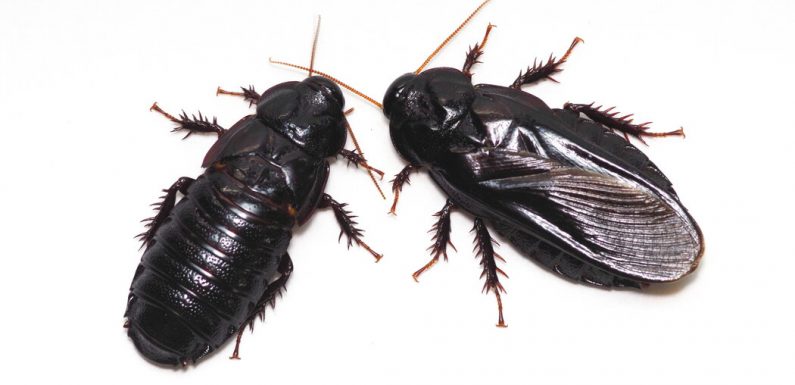
For certain cockroaches living inside rotten logs in Asia, nothing says “I love you” like some minor cannibalism.
Newly mated pairs of one species, Salganea taiwanensis, take turns chewing each other’s wings down to stubs after they move into the homes where they will jointly raise babies. Scientists say this unique behavior may have evolved because of the roaches’ truly monogamous bond.
Haruka Osaki, who published the finding last month in Ethology, first happened upon some wingless roaches in 2014. She had been collecting insects from the woods as a hobby since becoming a biology student at Kyushu University in Japan the previous year. “When I caught the wood-feeding cockroaches in the wild, I noticed that their wings were chewed by something,” Ms. Osaki said.
When it was time to choose a topic for her doctoral research a couple of years later, Ms. Osaki thought of the roaches. She knew from others’ observations that the damage probably didn’t come from predators, but from cockroaches eating each other’s wings. But she didn’t know why. Her adviser, Eiiti Kasuya, encouraged her to dive in.
Ms. Osaki collects her study subjects, which as adults have dark, glossy bodies about an inch long, from the wild.
“I walk into the Okinawan forest and search for rotten logs,” she said. “The cockroaches live in tunnels in rotten wood, so I destroy the wood with a hatchet and pick them up.” She packs the roach colonies into containers, then flies with them back to her laboratory in Fukuoka.
After some of her young, wild-caught cockroaches matured into adults, Ms. Osaki paired them off in the lab, creating 24 couples. Then she recorded their behavior with video cameras for three days.
The videos revealed that the roaches ate each other’s wings in stages. One bug would climb on the other’s back and eat, while the other sat motionless. Then they took a break before they resumed, sometimes swapping positions.
At times, the cockroach being munched on gave a violent shudder, which seemed to encourage the muncher to take a break. But the cockroaches otherwise didn’t seem to mind having their appendages gnawed off. Twelve of the couples ate each other’s wings completely.
Wood-eating cockroaches aren’t the only creatures that make a meal out of their mates, but their motivations may be unique.
“Cannibalism is quite frequent in spiders,” said María José Albo, an evolutionary biologist at the University of the Republic in Uruguay. Among sexually cannibalistic spiders and insects such as praying mantises, it’s usually a larger female who eats her mate. Although on the surface it seems like a bad outcome for the male, he may benefit by transferring more sperm while the female dines, Dr. Albo said.
On a less gruesome note, Dr. Albo added, some male insects and spiders give their mates a so-called nuptial gift: food that’s sometimes made from the male’s own body. The gift may buy him more time to mate — or to escape.
All of these cases involve only one mate being fed, Dr. Albo said, which makes the cockroaches so unusual. “If the mutual wing-eating has fitness benefits for both sexes, it will be the first case of mutual gift-feeding,” she said.
Those benefits probably aren’t nutritional, Ms. Osaki and Dr. Kasuya wrote, because the cockroach wings aren’t fleshy. But the roaches probably do benefit from losing their wings, because wings are cumbersome when living in tight quarters. Wings can also collect mold or mites, the authors wrote.
“It makes sense that there’s an advantage to getting rid of your wings if you’re not going to fly ever again,” said Allen J. Moore, an evolutionary biologist at the University of Georgia. Some other insects that live underground or inside wood also shed their wings after mating, such as termites, close relatives that Dr. Moore called “just fancy cockroaches.”
But these insects have to lose their wings on their own. “This mutual helping is just really unique,” he said.
Dr. Moore agreed with the authors that the cockroaches’ cooperative behavior most likely stems from their monogamy.
Once they’re coupled, the roaches will never again leave their rotten log or encounter other potential mates. From an evolutionary standpoint, they share the same interests. They both want to stay alive and take care of their young. (The cockroaches have also been observed guarding their babies from predators and even feeding them fluids from their own mouthparts, as birds do.) The parents may as well cooperate — and they start by helping each other shed their wings.
Essentially, the cockroach partners may be scratching each others’ backs — with their mandibles.
If this is confirmed, it will be a rare example in nature of mates that truly want the same thing, Ms. Osaki said, adding, “Sexual conflict has been always assumed.”
Source: Read Full Article